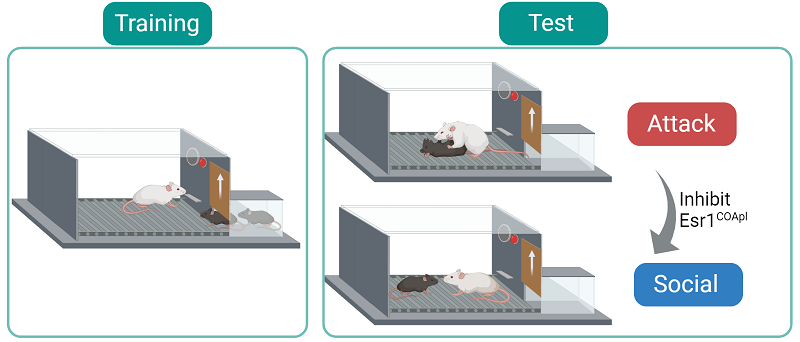Scientists Reveal Neural Circuitry Behind the Transition from Aggressive Behavior to Pro-social Behavior
Aggressive behavior is an evolutionarily conserved trait composed of an appetitive phase and a consummatory phase. While previous studies have identified several brain regions, including the ventromedial hypothalamus (VMHvl), lateral habenula (LHb), posterior amygdala (PA), and posterior zona incerta (pSI), that regulate aggression, the neural mechanisms underlying the transition between the appetitive and consummatory phases of aggressive behavior remain unexplored.
On February 12, 2025, a collaborative study between Dr. LI Long's group from the Institute of Biophysics, Chinese Academy of Sciences, and Dr. Scott Russothe's group from the Icahn School of Medicine at Mount Sinai, published in Nature, revealed that estrogen receptor alpha (Esr1) neurons in the cortical region of the amygdala (COApl) play a crucial role in regulating the transition between aggressive and pro-social behaviors.
Using the Swiss-Webster (SW) mouse strain, the researchers identified high-aggressive mice (AGG) and non-aggressive mice (NON) through the "resident-intruder" behavioral paradigm. They then developed a novel behavioral paradigm to measure aggression motivation and reward, using a modified Skinner box to train mice to press a lever to open an electric door, providing them the opportunity to attack other mice.
This study showed that SW mice were highly motivated by this task, indicating strong aggression drive, which was further reinforced when the aggression was satisfied. This was evidenced by a rapid increase in lever-press frequency, a reduction in the latency to attack, and a significant increase in attack duration.
Using whole-brain clearing technology (iDISCO+) and c-Fos neuronal labeling, the researchers identified a key cluster involved in aggression: the posterolateral cortical amygdala (COApl).
Fluorescent in situ hybridization experiments and fiber-optic recordings of neuronal activity revealed that COAplEsr1-expressing neurons specifically in male mice represent the transition between the appetitive and consummatory phases of aggression.
This study highlights the role of COAplEsr1 cells in modulating aggression in male mice by responding to social stimuli, thus enhancing their salience and facilitating attack behavior.
These findings could provide important insights into the neural circuits underlying aggression and social behaviors, with potential implications for understanding aggression in humans and developing targeted therapeutic approaches for related psychiatric disorders.

Fig.1. Left: Aggression reward training paradigm,Right: Inhibiting COAplEsr1 neurons leads to a significant decrease of attacking, and increase of social investigation.
(Image by LI Long's group)
Article link: https://www.nature.com/articles/s41586-024-08540-4
Contact: LI Long
Institute of Biophysics, Chinese Academy of Sciences
Beijing 100101, China
E-mail: longli@ibp.ac.cn
(Reported by Prof. LI Long's group)

